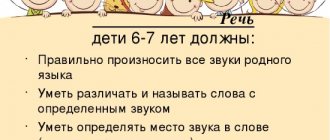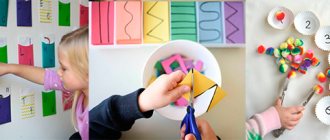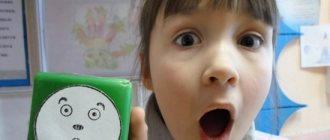The speech development of children 4-5 years old refers to the period of visiting kindergarten, when the child is actively learning about the world around him and relationships in society. It is a mistaken opinion that only a preschool institution should work with a baby, where he will be taught to draw, sculpt, and speak correctly. If parents want to have an educated child in the future who is interested in reading and has no speech problems, it is imperative to devote time to speech development at home. Additional activities will help prepare your child for school and facilitate the process of learning, reading and writing in the future.
Features of speech at 4-5 years old
By the age of 4, a child’s speech becomes more conscious and acquires contextual meaning. Before expressing a thought, the baby carefully thinks through what is said, determines when and what can be said. The act of speaking now depends on the society in which the baby is at the moment, on the context. The level of speaking increases as a result of studying and understanding the basics of the native language. The baby understands how to correctly express his own thoughts, how to logically construct a sentence.
By the age of 4-5 years, children’s speech changes, which is manifested in the following signs:
- The language is enriched, passive and active vocabulary is constantly increasing.
- The baby speaks more and more in sentences that are logically structured and rich in content.
- In a conversation, the baby operates with complex and compound sentences; his statements contain conjunctions, prepositions, and pronouns.
- The softened pronunciation of consonant sounds disappears, replacing whistling and hissing sounds.
- It becomes easier for the child to perceive sound speech by ear.
- The process of speaking is increasingly meaningful.
- The baby makes fewer abbreviations, omissions of words, substitutions, etc.
- The baby likes to sing songs, recite poems and fairy tales, and retell stories.
Teachers and speech therapists identify 10 main characteristics of speech related to developmental norms characteristic of 4-5 years:
- “Word creativity” is actively developing, the baby comes up with and invents his own words.
- Children can name the seasons, animals, and their babies.
- The vocabulary reaches 2000 words.
- In conversation, the baby uses pronouns, nouns, verbs, adverbs, participles, adjectives, conjunctions and prepositions.
- An understanding of the meaning of prepositions comes: in, on, for, in, before, etc.
- The baby can pronounce whistling and hissing sounds: Ts, Sh, Shch, Ch, S, Zh.
- Monologue speech appears.
- Sentences become richer: from 5 to 9 words.
- A child can recite a short poem by heart or retell a fairy tale with the help of an adult.
- Says actions during the game.
OHP level 2
Children with level 2 ODD use both words and babbling utterances in communication. The grammatical aspect of speech suffers seriously - there is no agreement between the noun and the verbs, words denoting the attribute or quality of an object are not used. Word formation skills are not available to the child.
In addition to working with the above problems, it is also necessary to carry out work on staging the pronunciation of sounds, as well as the development of phonemic analysis and synthesis.
Exercises:
- To improve phonemic awareness, games are offered to identify the desired phoneme. For example, the “Catch the Sound” exercise. The adult pronounces the word clearly and not very quickly, while the child must clap his hands or hit the table with his palm when he recognizes the desired sound.
- “Who made a mistake?” A similar game, but slightly changed. The teacher pronounces words, replacing a certain phoneme in them, and children must stomp or raise their hand when the word is pronounced correctly.
- The "Clap Your Hands" game gets a little more complicated. Now the claps will separate the syllables. We pronounce the word syllable by syllable, marking each of them with a clear clap.
- To develop the articulatory apparatus, children are required to do “Tongue exercises.” The tasks are offered from simple to complex and taking into account the individual needs of the child.
- "Who's the little one?" - a game to develop word formation skills. The teacher shows pictures of adult animals and their babies, clearly pronouncing their names. Intonation distinguishes the method of word formation. Now the child must say what is the name of the baby in the picture?
- Work is also being carried out to study word agreement. For example, using the game of finding a toy. The teacher hides an object, and the child must follow the instructions to find it (UNDER a chair, BEHIND a book, etc.).
- The development of coherent speech is carried out within the framework of discussion of game moments and fairy tales. The adult asks the children questions: who came to class? Where did the bun roll to?
- Games and exercises for the development of motor skills remain extremely relevant. Children are offered lacing, appliqué, shading and coloring. Finger games and exercises are included in every lesson.
Possible deviations
Modern kindergartens, as a rule, have speech therapists. The teacher diagnoses speech disorders when the child enters kindergarten and annually notes any changes. If there is a speech therapist in a preschool institution, the parent should go for a consultation and discuss the main points regarding the child’s speech development. A professional will tell you what sounds to pay attention to and whether there are any other problems when speaking.
If it is not possible to visit a speech therapist, you can identify problematic sounds in pronunciation at home. It is important that the baby does not guess about the diagnosis and perceives the process as a game.
The level of development of the speech apparatus can be checked using special exercises. Cards with animals, insects, pieces of furniture, dishes, etc. are suitable for diagnostics. Parents play with their child in kindergarten or school when the adult is a teacher or educator, and the baby is in class with other dolls. The teacher shows the card, the baby’s task is to name the drawn object. When pronouncing words, the adult pays attention to individual sounds, whether the baby clearly pronounces sonorous, hissing, and whistling sounds.
You can play the game “Who says what?”, when the parent names the animal, the baby tries to imitate it using his voice: mu-mu, beee, meow, woof, etc. The task is also to observe the pronunciation of individual sounds, to catch what emphasis should be placed on speech development.
The following problems and deviations may be observed in the development of speech in children 4-5 years old:
- Skipping and replacing individual sounds in a word: R with L, Ш with Ш, etc.
- Incorrect understanding of the meaning of words, poverty of active vocabulary.
- Rhythmic disturbances: stuttering, logophobia, prolongation or sudden cutting off of sounds.
- Incorrect sentence construction.
- It is difficult for a baby to retell a short story, even with the help of an adult, or to learn a short poem.
Separately, it is necessary to say about SRD (delayed speech development). The diagnosis is made when there are a combination of several disorders, falling behind WHO standards. If the reason lies in social factors, it is easier to correct the situation. Neurological problems will require medical and speech therapy assistance.
Children's speech therapy chants
If a specialist is faced with the task of correcting the speech of children from two to three years old, then all kinds of chants are used to solve this problem. This choice is due to the natural relationship of the speech apparatus with music and movements. The text offered to them is of particular interest to children. A speech therapist contributed to the development of each of them, so they help children develop their imagination, increase their emotional state and make their mood joyful.
The more often the chants are performed, the faster children’s complexes regarding the fact that they are pronouncing any words or letters incorrectly go away. When performing a task, the main emphasis is on correct pronunciation and clarity. Children should develop the ability not to speak words, but to mint them.
It is also noted that primary school children also perform tasks of this type. They call it logorhythmic five-minute periods. When children repeat chants with some regularity, they develop hearing, singing ability, speech and movement.
Any speech therapist will tell you that you can’t just listen to chants. Each has its own methodology for working with children:
all chants are listened to according to the natural development of sounds: first vowels, then syllables with heavy consonants; chants should be accompanied by characteristic movements (display the essence of what the child is singing about); the work needs to be structured in such a way that the speech therapist or adult takes over from the chant the sounds that the baby is not working on, and the children sing what is being corrected; Initially, children need to recite the text of the chant, then accompany it with characteristic sounds (clicks, claps, stomp), and this will result in logorhythmics; The position of the children is also important; they should not sit, but, on the contrary, should actively participate in the process; Each vowel sound is shown by the speech therapist with his hands, and the child repeats after it.
Chants are considered one of the most effective exercises in speech therapy.
Reasons for violations
Children who cannot speak or have a limited vocabulary should cause concern for parents. It is necessary to show the baby to a neurologist, speech therapist, dentist, or orthodontist to determine the causes of silence or developmental delay.
A stimulating factor for a decrease in speech activity or its absence can be:
- An unfavorable speech environment when parents do not communicate with the baby, spend little time together, and do not read fairy tales and poems.
- Social environment, if parents have speech impairments, the child reluctantly adopts the style of speaking, copies adults, which develops into a habit that is difficult to get rid of with age.
- Problems from the field of neurology.
- Mental retardation, intellectual impairment.
- Problems with the organs of articulation (long tongue, high palate, malocclusion, frenulum defects).
Advice for parents and prevention of speech delay
Speech therapists give advice to parents on how to prevent developmental disorders at an early age, stimulate speech activity, and enrich the child’s vocabulary.
- Be sure to start communicating with your baby; the sooner this happens, the better. Psychologists talk about the importance of talking with a child during intrauterine development and immediately after birth with mom and dad.
- You need to read fairy tales to your baby, even if the adult thinks that the baby is not interested and does not understand anything. From the age of six months, it is recommended to tell children funny nursery rhymes, sing songs, and read rhymes during massages, walks, games, and gymnastics.
- Consult specialists (dentist, neurologist) in a timely manner to notice the problem at an early stage.
- Buy your child more educational games: puzzles, puppet theater, picture cards, kitchen modules. Do not leave the baby alone with toys, play with him, and actively involve him in conversation.
- Carry out articulation warm-ups with the baby, practice logarithmics, even if there are no obvious problems in speech.
- The fifth year for girls is interesting because active role-playing appears. You need to take advantage of this, play kindergarten, school, mother and daughter, etc. with your baby.
- Enrich the child’s inner and spiritual world: visit museums, circuses, performances.
The family plays the main role in the development of speech. If parents read fairy tales to their baby from an early age, tell rhymes, sing songs, talk about environmental phenomena, the baby will not have problems with active vocabulary.
OHP level 1
Level 1 speech underdevelopment in children is characterized by the presence of babbling speech with the active help of facial expressions and gestures. The lexical vocabulary is limited to onomatopoeias and syllables that sound similar to the words the child needs. The grammatical part of speech is not developed; even if phrases of several words are constructed, they are absolutely not consistent with each other. At the same time, auditory and visual attention and memory are impaired.
In correctional classes, the main emphasis is on expanding the child’s active and passive vocabulary, developing attention, improving fine motor skills and the functioning of the articulatory organs.
Games and exercises:
- To improve the perception of non-speech sounds, the game “What does it sound like?” is used. The child is invited to listen to various everyday sounds (the rustling of paper, the sound of pouring water), the sound of musical instruments or toys. Then, having heard familiar sounds, the child must show what kind of object makes them.
- The game of blind man's buff is also good for activating auditory attention. Blindfolded, children must catch the leader clapping his hands, focusing on the sound.
- To expand the lexical vocabulary, didactic games are played - “Who came?”, “Parts of the body”, “Fruits and vegetables”, etc. The toys are shown to the child and their names are pronounced clearly. After this, the children must name the objects themselves.
- “Clap like me!” - the teacher claps his hands several times at different tempos, the children must reproduce the rhythmic pattern.
- To develop fine motor skills, drawing, modeling, finger games, picking through cereals, and playing with sand are used.
- “Look Carefully” - coloring game. According to the instructions of the adult, the child must color only the necessary images in the picture (only fruits or vegetables or animals).










